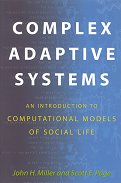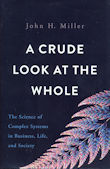Imagine trying to understand a stained glass window by breaking it
into pieces and examining it one shard at a time.
While you could probably learn a lot about each piece,
you would have no idea about what the entire picture looks like.
This is reductionism—the idea that to understand the world
we only need to study its pieces—and
it is how most social scientists approach their work.
In A Crude Look at the Whole, social scientist and economist
John H. Miller shows why we need to start looking at whole pictures.
Whether we are talking about stock markets, computer networks, or biological organisms,
individual parts only make sense when we remember that they are part of larger wholes.
More importantly, those wholes can take on behaviors that are strikingly different
from that of their pieces.
Miller, a leading expert in the computational study of complex adaptive systems,
reveals astounding global patterns linking the organization of
otherwise radically different structures.
It might seem crude, but a beehive’s temperature control system
can help predict market fluctuations
and a mammal’s heartbeat can help us understand the
“heartbeat” of a city and adapt urban planning accordingly.
From enduring racial segregation to sudden stock market disasters,
once we start drawing links between complex systems,
we can start solving what appear to be intractable problems.
Thanks to this revolutionary perspective, we can finally transcend
the limits of reductionism and discover crucial new ideas.
Scientifically founded and beautifully written,
A Crude Look at the Whole is a powerful exploration of
the challenges that we face as a society.
As it reveals, taking the crude look might be the only way to truly see.
Most systems in the real world are complex:
they are made of very many components,
whose non-linear interactions result in high level emergent properties
that are not simply related to the properties of those components.
How to study such systems?
Studying the components in isolation is insufficient:
their interactions with each other and with their surroundings are key.
Studying the whole system in detail is infeasible:
there are too many components and interactions to grasp the whole in detail.
So Miller advocates studying the whole as a whole.
He devotes individual chapters to different facets of this whole –
interactions, feedback, heterogeneity, noise,
molecular intelligence, group intelligence,
networks, scaling, cooperation, and self-organised criticality;
and also the MCMC algorithm for studying these
–
explains how a degree of understanding can be obtained,
and gives a range of examples, covering physical, biological,
social, and economic systems.
There are many fascinating insights along the way.
For example, many computer simulations of ‘complex’ systems
use (relatively) homogeneous agents.
Miller shows how heterogeneous agents (varying in some trait or property)
can either stabilise a system against tipping, or cause it to tip more rapidly,
depending on the sign of the feedback.
So results from homogeneous simulations,
and similarly simulations lacking noise,
may give quite misleading results.
The chapter on molecular intelligence describes how complex adaptive behaviours
(one might call this, intelligence) does not need a brain:
complex molecular chemistry, feedback loops, and decay processes,
all tuned by evolution, can deliver startling results.
Intelligence can also arise from more complex agents interacting through feedback loops:
the chapter on group intelligence discusses how swarms of bees
can exhibit a group intelligence that no individual bee possesses.
There are also a few peculiarities.
For example, in the chapter on noise,
Miller discusses a search procedure for finding novel drug cocktails.
Such cocktails can be much more effective than the drugs taken individually,
since they can interact in non-linear ways
(they are not just the sum of their individual effects);
Miller states that:
[p92]
drugs often interact with one another in surprising ways.
However, only a few pages later, he laments that
[p97]
the Food and Drug Administration currently requires that cocktails
be tested and approved as a cocktail—an extremely costly
process—even when the drugs that make up
the cocktail are all individually approved.
Well, yes. Because they often interact with one another in surprising ways.
The majority of the chapters discuss these processes in non-technical ways,
and are the stuff of many a popular book on complex systems,
although here illustrated with a wider range of examples than usual.
The final chapter, however, moves into territory rarely explored in popular books:
the MCMC (Markov Chain Monte Carlo) algorithm.
(I think the explanation suffers a little in clarity
from the understandable desire not to uses any mathematics.)
He explains the genesis of the algorithm,
invented to model distributions underlying certain physical processes,
and how it can be used to understand some of the operations of a complex system:
[p215]
The mechanisms that drive adaptive systems, such as evolution,
have direct analogs to the key elements of the MCMC algorithm.
In short, a complex adaptive system behaves as if
it were implementing a MCMC algorithm.
That provides great potential for an explanatory and even predictive approach
to complex systems of interacting components.
However, I suspect that once the components have ‘true’ intelligence –
can apply reasoning to their own actions and actions of others,
and change their behaviours based on that reasoning –
their recursive natures will make the system even more complex,
and a more sophisticated explanatory approach will be needed.
Despite some minor caveats, this is an interesting book, well written,
covering a lot of very deep and important concepts.

